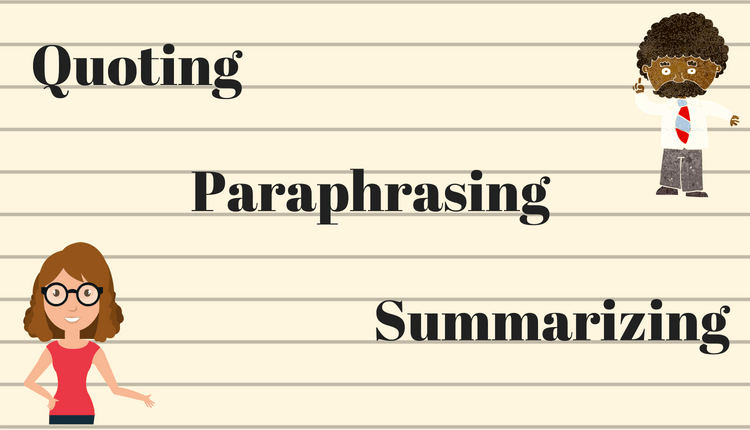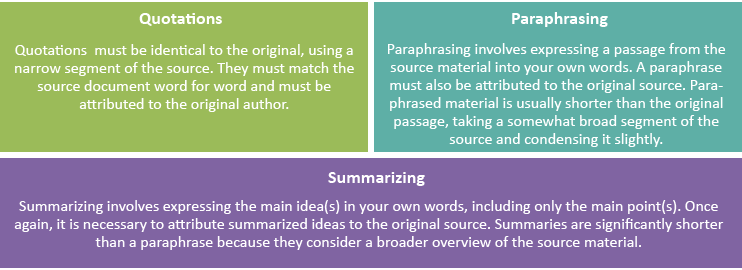Summarizing and Paraphrasing in Academic Writing

“It’s none of their business that you have to learn to write. Let them think you were born that way.”
– Ernest Hemingway
Plato considers art (and therefore writing) as being mimetic in nature. Writing in all forms and for all kinds of audience involves thorough research. Often, there is a grim possibility that an idea you considered novel has already been adequately explored; however, this also means there are multiple perspectives to explore now and thereby to learn from.
Being inspired by another’s idea opens up a world of possibilities and thus several ways to incorporate and assimilate them in writing, namely, paraphrasing, summarizing, and quoting. However, mere incorporation does not bring writing alive and make it appealing to readers. The incorporation of various ideas must reflect the writer’s understanding and interpretation of them as well.
 What is Quoting, Paraphrasing, and Summarizing in Academic Writing?
What is Quoting, Paraphrasing, and Summarizing in Academic Writing?
Purdue OWL defines these devices of representation quite succinctly:

Therefore, paraphrasing and summarizing consider broader segments of the main text, while quotations are brief segments of a source. Further, paraphrasing involves expressing the ideas presented from a particular part of a source (mostly a passage) in a condensed manner, while summarizing involves selecting a broader part of a source (for example, a chapter in a book or an entire play) and stating the key points. In spite of subtle variations in representation, all three devices when employed must be attributed to the source to avoid plagiarism.
Related: Finished drafting your manuscript? Check these resources to avoid plagiarism now!
Why is it Important to Quote, Paraphrase, and Summarize?
Quotations, paraphrases, and summaries serve the purpose of providing evidence to sources of your manuscript. It is important to quote, paraphrase, and summarize for the following reasons:
- It adds credibility to your writing
- It helps in tracking the original source of your research
- Delivers several perspectives on your research subject
Quotations/Quoting
Quotations are exact representations of a source, which can either be a written one or spoken words. Quotes imbue writing with an authoritative tone and can provide reliable and strong evidence. However, quoting should be employed sparingly to support and not replace one’s writing.
How Do You Quote?
- Ensure that direct quotes are provided within quotation marks and properly cited
- A Long quote of three or more lines can be set-off as a blockquote (this often has more impact)
- Short quotes usually flow better when integrated within a sentence
Paraphrasing
Paraphrasing is the manner of presenting a text by altering certain words and phrases of a source while ensuring that the paraphrase reflects proper understanding of the source. It can be useful for personal understanding of complex concepts and explaining information present in charts, figures, and tables.
How Do You Paraphrase?
- While aligning the representation with your own style (that is, using synonyms of certain words and phrases), ensure that the author’s intention is not changed as this may express an incorrect interpretation of the source ideas
- Use quotation marks if you intend to retain key concepts or phrases to effectively paraphrase
- Use paraphrasing as an alternative to the abundant usage of direct quotes in your writing
Summarizing
Summarizing involves presenting an overview of a source by omitting superfluous details and retaining only the key essence of the ideas conveyed.
How Do You Summarize?
- Note key points while going through a source text
- Provide a consolidated view without digressions for a concrete and comprehensive summary of a source
- Provide relevant examples from a source to substantiate the argument being presented
“Nature creates similarities. One need only think of mimicry. The highest capacity for producing similarities, however, is man’s. His gift of seeing resemblances is nothing other than a rudiment of the powerful compulsion in former times to become and behave like something else.”
–Walter Benjamin
Quoting vs Paraphrasing vs Summarizing
|
Quoting |
Paraphrasing |
Summarizing |
| Quoting means to reproduce a statement word-for-word as it appears in its original source. | Paraphrasing means to reframe a sentence from its original source without changing the meaning. | Summarizing means to shorten a longer statement or context into a smaller one keeping its crux intact. |
Research thrives as a result of inspiration from and assimilation of novel concepts. However, do ensure that when developing and enriching your own research, proper credit is provided to the origin. This can be achieved by using plagiarism checker tool and giving due credit in case you have missed it earlier.
Source: https://student.unsw.edu.au/paraphrasing-summarising-and-quoting










Amazing blog actually! a lot of information is contained and i have really learnt a lot. Thank you for sharing such educative article.
hi,
I enjoyed the article. It’s very informative so that I could use it in my writings!
thanks a lot.
hi
You are really doing a good job
keep up the good work
Great job! Keep on.
nice work and useful advises… thank you for being with students